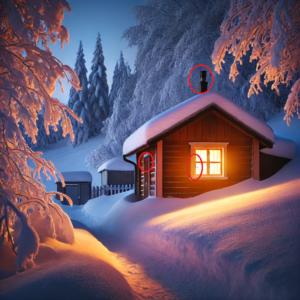What would you do if the sky turned black, the power went out, and the road to help was suddenly cut off? Natural disasters strike fast—and sometimes without warning. Whether it’s a hurricane, wildfire, flood, or blizzard, your family’s safety depends on how well you’ve prepared. And no, that doesn’t mean having a bunker in the backyard or a closet full of MREs.
It means having a plan, knowing what to grab, and being able to move—or hunker down—at a moment’s notice.
Here are five practical ways to protect your family during a natural disaster—no panic, just solid preparedness.
Build a Family Emergency Plan That Everyone Understands
When disaster hits, confusion is your enemy. A clear, practiced family plan cuts through the chaos. You don’t want to be shouting directions in the middle of a storm. Everyone in your household, from your spouse to your youngest child, should know exactly what to do.

Start by picking two meeting points—one near your home, and another outside your neighborhood in case you can’t return. Choose an out-of-town emergency contact each family member can reach to check in. Write down phone numbers. Store them in wallets, backpacks, and even your vehicle glove box.
Practice your plan at least twice a year. Make it a game if you have young kids. When it becomes second nature, you won’t be wasting time making decisions when minutes matter most.
Create a Go-Bag for Every Family Member
If you need to evacuate fast, the last thing you want to do is scramble for socks and a flashlight. A go-bag—sometimes called a bug-out bag—should be packed and ready for each family member, including pets.

At minimum, each bag should include water, non-perishable food for 72 hours, a flashlight with extra batteries, first-aid supplies, a multi-tool, and weather-appropriate clothing. For kids, include comfort items like a stuffed animal or book. For adults, don’t forget copies of IDs, medication, and a USB stick with important documents.
You don’t have to drop hundreds of dollars to get started. Build your bags slowly over time with things you already own. A few minutes spent packing today could save you hours—or your life—tomorrow.
Secure Your Home Before the Storm Hits
You can’t always leave. Sometimes the safest option is to shelter in place. That’s why prepping your home ahead of time is critical. Before hurricane season, clear gutters and trim weak branches that could fall. In wildfire-prone areas, keep defensible space around your home and store flammable items away from the structure.

Secure heavy furniture and appliances that could tip during an earthquake. Have plywood or storm shutters ready to board up windows.
And here’s a simple but often forgotten step—know how to shut off your gas, water, and electricity. In the wrong situation, a broken gas line or electrical surge can be more dangerous than the storm itself.
Related: How to Use Natural Barriers to Protect Your Home
Have an Off-Grid Communication Backup
In a major disaster, cell towers can go down. The internet goes out. Your smartphone turns into a paperweight. How will you get updates or call for help?

You need backup. A hand-crank or battery-powered NOAA weather radio is your best bet for real-time emergency broadcasts. Some models even let you charge small devices with solar or crank power. For local coordination, consider walkie-talkies or two-way radios with a decent range.
Write down emergency frequencies and keep a printed copy of local shelter locations and disaster relief contacts. You’ll be grateful you did when the lights go out and the signal drops.
Stock Smart, Not Just Deep
Sure, a wall of canned chili looks impressive. But will it keep your family going long term? Focus on practical, nutritious, and easy-to-prepare foods. Think rice, beans, oats, and shelf-stable proteins like peanut butter or canned meats.

Don’t forget water—at least one gallon per person per day for drinking and hygiene. If space is tight, get a quality water filter or purification tablets as backup. Also include hygiene items, prescription meds, and a basic first-aid kit with bandages, antiseptic, and over-the-counter essentials like pain relievers and anti-diarrheals.
Remember: this isn’t about hoarding. It’s about resilience. When the shelves are bare and the roads are blocked, your supplies become your lifeline.
Conclusion
You can’t stop a natural disaster—but you can control how your family responds. With the right planning, supplies, and mindset, you’ll be better prepared for whatever comes your way. Start simple. Build slowly. Focus on real needs and realistic solutions.
Next time you check the weather and see a storm brewing, ask yourself: if it hits tonight, are we ready?
If not, today’s the day to change that.






